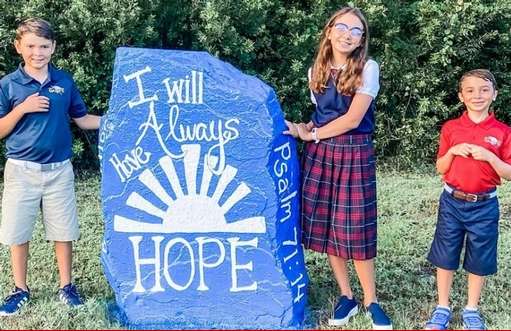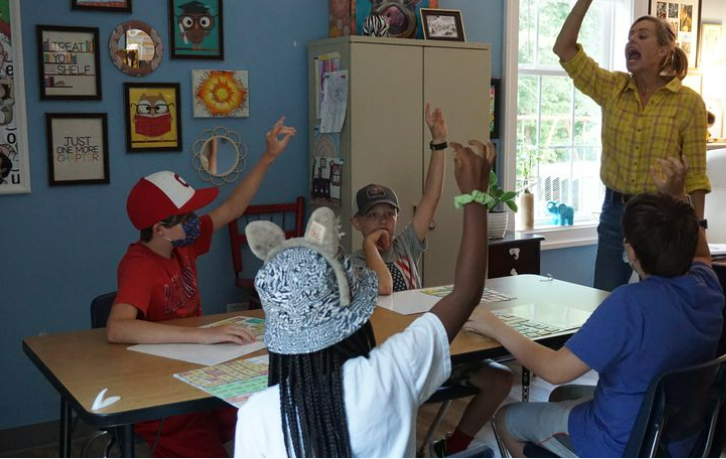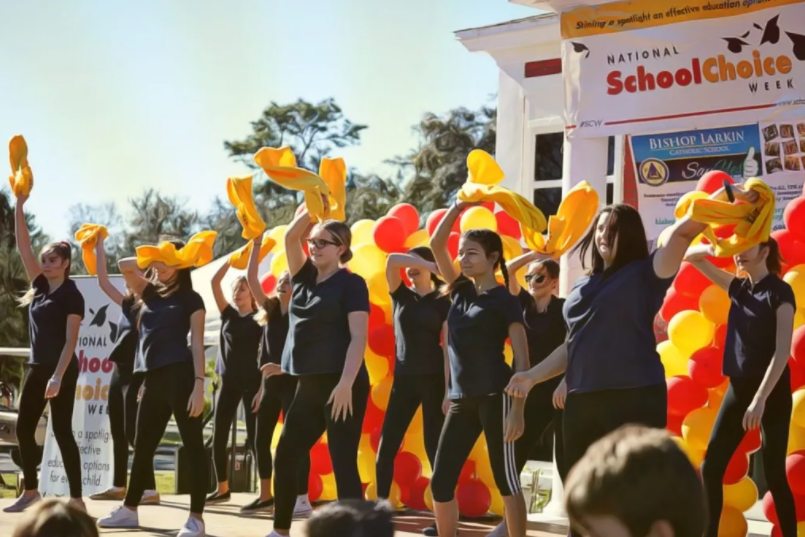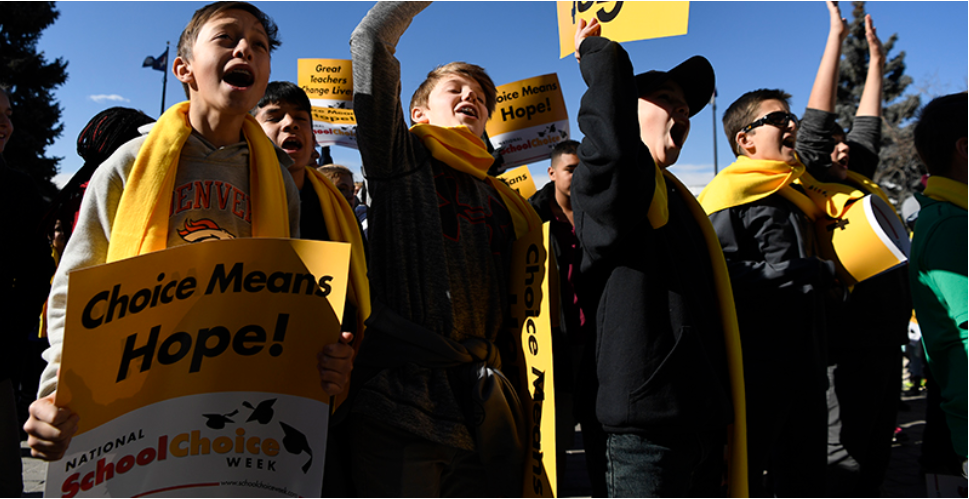Choice opponents have been known to throw contradictory arguments out against private choice programs. One moment they will claim that the majority of kids using universal choice programs were already going to private schools. A few moments later they will claim such programs are draining district schools of students and money. The irony of these mutually exclusive claims will often escape the person making them, and you can see hints of both in this New York Times podcast titled Why So Many Parents are Opting Out of Public Schools.
Sigh
Choice opponents make all kinds of claims, but not many can withstand even a modicum of scrutiny. Let’s take for instance a widely repeated fable- that Arizona’s universal ESA program has “busted” the state budget.
If you actually examine state reports like this one for district and charter funding and also this one for ESA funding, you wind up with:
Arizona districts have exclusive access to local funding among other things and are by far the most generously funded K-12 system in the state. Districts, charters and ESAs all use the state’s weighted student funding formula, and ESAs get the lowest average funding despite having a higher percentage of students with disabilities participating than either the district or charter sector.
If you track the percentage of students served by the district, charter and ESA sectors respectively, and the funding used by each as a percentage of the total, you get:
So, there you have it; supposedly the sector educating 6% of Arizona students for 4% of the total K-12 funding is “bankrupting” the state of Arizona. Meanwhile the system, which generated an average of $321,700 for a classroom of 20 ($16,085*20), is “underfunded.”
A group of 20 ESA students receiving the average scholarship amount receive $123,780 less funding, but they are (somehow) “busting the budget.” The fact that a growing number of Arizona students opt for a below $10k ESA rather than an above $16k district education tells us something about how poorly districts utilize their resources. So does the NAEP.
There is a school sector weighing heavily upon Arizona taxpayers, but it is not the ESA program.

Nationally K-12 STEM certified Christian Academy of Myrtle Beach, whose mission is to develop young Christian leaders through partnering with parents and to fuse Christian faith with academics, athletics, and fine arts, is one of 419 private schools in South Carolina. Head of school Katherine Cannon says while the school offers tuition assistance, the education savings account program would expand eligibility to more low-income families.
Horse racing, teacher raises, and a budget flush with cash. South Carolina lawmakers have plenty to debate before the legislative session ends June 15. But parents hope legislators don’t bolt for home before finally offering K-12 students more quality learning options.
Recently, the S.C. House of Representatives flew through budget negotiations, completing the process in a matter of hours. They approved a proposal containing billions in new federal taxpayer spending, along with provisions that boost teacher pay and give bonuses to state employees.
Lawmakers in both chambers are also considering legalizing gambling on horse racing as yet another way to increase state revenue. But while they debate the merits of racetrack betting, South Carolina parents and K-12 students are left sitting in the stands, waiting for state officials to wager that families know what is best for a child’s future.
Lawmakers are considering proposals to allow students to use education savings accounts to choose how and where they learn. As readers of reimaginED will know, some residents in neighboring North Carolina can already use their child’s portion of state education spending to meet a child’s unique learning needs. Those funds, deposited in individual accounts, may be used to purchase textbooks, hire a personal tutor, find an education therapist, pay private school tuition, and more.
The education savings accounts allow families in North Carolina (and 10 other states, including Florida, with similar account options) to customize their child’s learning experience. Parents and students can choose a new school and get help with challenging coursework and pay for textbooks and learning materials to challenge their student or help them catch up to their peers.
While S.C. representatives finished the budget in record time this year, they have continued to drag their feet in bringing education savings accounts to state families. Since 2017, lawmakers in North Carolina, Kentucky, Missouri, New Hampshire, West Virginia, and Indiana have managed to enact the accounts for their constituents. Florida, Tennessee, Mississippi, and Arizona lawmakers had already made the accounts available to thousands of students.
Despite all this progress elsewhere, movement in the South Carolina legislature has stalled over the years.
Currently, South Carolina lawmakers are considering two proposals—one in each chamber—that would give families and their students quality education opportunities similar to the accounts in these other states.
The proposal before state senators, in particular, would give students a range of choices, like the accounts described in North Carolina, Florida, and elsewhere. The Senate proposal would let students choose a new school and/or a set of services, including personal tutors and computer hardware to help with online course delivery. Lawmakers in both the House and Senate have the chance again to complete what can only be considered unfinished business for state families.
South Carolina students need help now. In one of the state’s largest cities, Greenville, the number of students earning failing grades reportedly tripled in 2020. Student achievement among those attending schools along the I-95 corridor--the subject of much discussion in recent years due to litigation over South Carolina education spending—still trail statewide averages, according to Palmetto Promise Institute research. Statewide, there is a 30-point difference between white students and black students in 4th grade reading.
The need for action, for viable education options, is urgent.
State families should not have to wait another year to see how many other states create account options for K-12 students before South Carolina acts. Lawmakers showed they can move quickly to formulate a budget. They should apply the same urgency to helping students.

Brookwood Christian School in Acworth, Georgia, serves students who have not been successful in public or private schools due to their unique learning needs. The school participates in the Georgia Special Needs Scholarship Program.
Editor’s note: This article appeared Monday on The Center Square.
Georgia's school choice programs saved taxpayers at least $605 million in fiscal year 2018, an updated analysis by EdChoice found.
EdChoice examined the fiscal effects of 40 private educational choice programs in 19 states and the District of Columbia. The nonprofit found the Georgia Special Needs Scholarship Program and the Georgia Qualified Education Expense Tax Credit saved taxpayers between $605 million and $1.1 billion in fiscal 2018.
Each taxpayer saved money on the sum they would have paid in taxes for each student enrolled in the program to attend public schools. The programs saved each taxpayer between $4,355 to $8,013 per student, according to the report.
Georgia Center for Opportunity Vice President of Public Policy Buzz Brockway said the report dispels some misconceptions about school-choice programs.
"There is a falsehood out there that if we expand access to different educational options for Georgia families, we'll end up hurting traditional public schools," Brockway said. "Data like this from EdChoice clearly show this isn't the case."
To continue reading, click here.

Florida parents rally in the capitol complex for the ability to pick the best option for their children regardless of their ZIP code during National School Choice Week.
Editor’s note: This commentary from EdChoice director of national research and reimaginED guest blogger Mike McShane appeared Thursday on forbes.com. Be sure to check back Monday to listen to a podcast with McShane conducted by reimaginED executive editor Matt Ladner.
School choice is having a moment right now.
2021 yielded a bumper crop of school choice legislation. The idea of parental voice and parental choice has rocketed to the forefront of the political debate, to the point of potentially tipping elections.
Max Weber said that politics is “the strong and slow boring of hard boards.”
Changing public policy requires changing people’s minds, then encouraging them to act, then responding to others who think differently, then revising plans, and on and on and on.
While electoral victories can be invigorating in the short term, anyone who has observed government and society for any length of time knows that real, durable change takes years of strong and slow boring.
Amidst the fervor and the fanfare, careful, methodical thinking is more important than ever.
To that end, my colleague Marty Lueken, director of the Fiscal Research and Education Center at EdChoice, has published an authoritative examination of the fiscal impact of private school choice programs. After examining 40 different programs in different states and at different times, he estimates that they have generated between $12.4 billion and $28.3 billion in net fiscal savings.
This works out to between $3,300 and $7,500 per participating student or $1.80 to $2.85 saved per dollar spent, depending on how you want to look at it.
To continue reading, click here.
 Editor’s note: This commentary from Aaron Smith, director of education policy at the Reason Foundation, characterizes Florida as “the nation’s school choice bellwether.” It appears today on the National Review.
Editor’s note: This commentary from Aaron Smith, director of education policy at the Reason Foundation, characterizes Florida as “the nation’s school choice bellwether.” It appears today on the National Review.
As public-school battles over masks, vaccinations, and critical race theory continue, one thing is for certain this year: The demand for school choice will be stronger than ever.
Yet misconceptions about school-choice programs draining funding from public schools still abound. As students head back to the classroom and state legislators get back to session this fall, it’s critical we understand where education dollars are really going.
The reality is that spending on school-choice programs pales in comparison to recent increases in employee- and retiree-benefit costs for education systems across the country. Today, state spending on school-choice programs such as vouchers, education savings accounts, and tax-credit scholarships accounts for less than 0.4% of total U.S. K–12 public-education expenditures.
To put this in perspective, if school choice were defunded in, say, Maryland, Utah, and Mississippi, the states’ savings could boost public-school funding by less than $10 per student in each state — and that’s before accounting for the costs of absorbing private school students back into district schools.
Even Florida, the nation’s school-choice bellwether, could save only an extra $405 per student if choice programs were cut — a small fraction of what it spends on public schools each year.
To continue reading, click here.